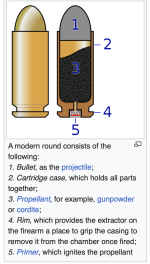Might you mean you mark the dowel at the level of the case mouth? Though, I suppose, technically, the case mouth has a rim, too, just not a flanged one.
HighValleyRanch:
A simple computation:
Seating Depth = Case Length + Bullet Length - COL
Determine your seating depth, as above, and open your caliper jaws to that number. Park the back of the beam on the edge of the case mouth and add powder until it is level with the beam. Weigh the charge, and you will know how much you can put in before you start compressing the load.
Note that the above will change with cases, so you want to find a range. Sample some of your heaviest and lightest cases to get some idea of what difference you are dealing with. There is no commercial case capacity specification; just exterior dimension limits.
Note that powder density varies some by lot. Western Powders, before Hodgdon bought them, used to publish bulk density and its lot-to-lot tolerance, and ±5.6% (a span of 11.2%) was the largest one, and ±2.2% (4.4% span) was the smallest. So, you will have to make this determination again when you buy more powder.
AlanWK,
Do your resized and untrimmed but not yet expanded cases plunk into but protrude from the back end of the barrel? If so, take a caliper to them. If they do not exceed the SAAMI maximum case length of 0.745" but are sticking out and are plunking in without dragging on the sides of your chamber, the chamber is too short and out of spec. A gunsmith can fix that. But if they are longer than 0.745" at that point, it may be you have a tight (small base) resizing die, and it is squeezing the brass out too long, requiring you to trim. Still, you should only need to trim once with 9mm Luger cases, and they should be good to go using that resizing die after that.

